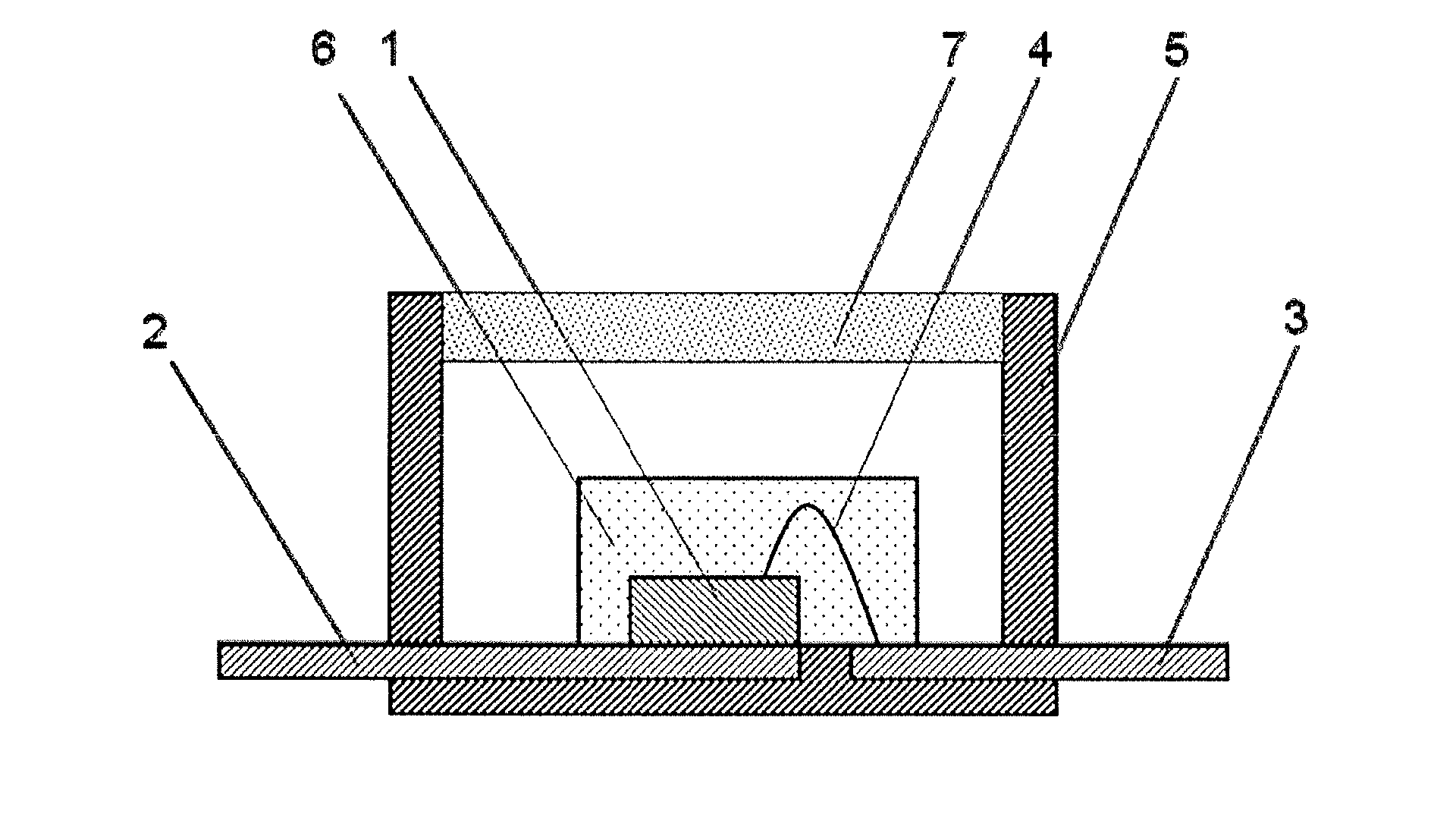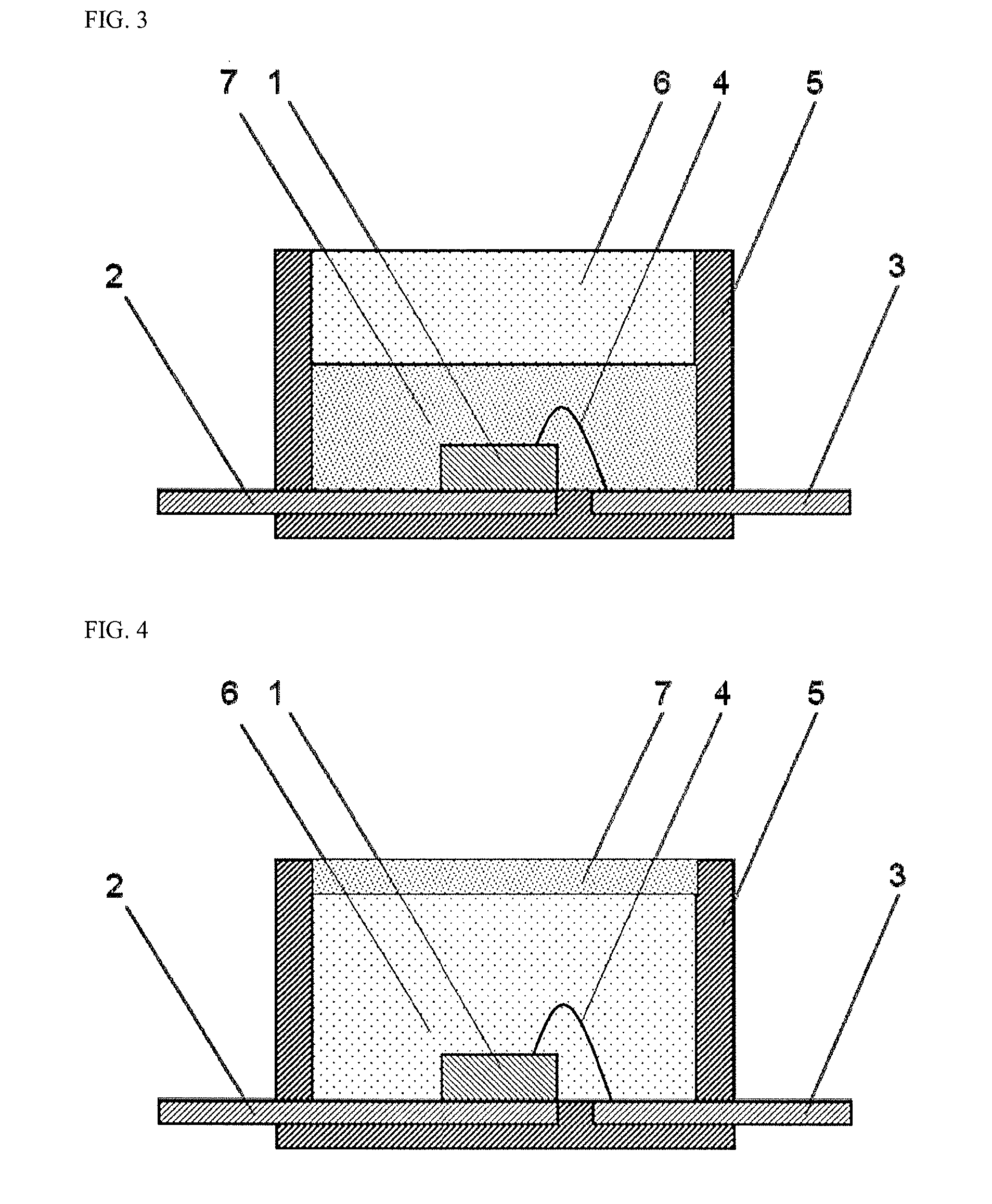Curable Silicone Composition, Cured Product Thereof, And Optical Semiconductor Device
a silicone composition and silicone technology, applied in the direction of semiconductor/solid-state device details, organic chemistry, coatings, etc., can solve the problems of organopolysiloxane containing cerium yellow color, deformation of adhesion and sealing performance with a substrate, and inability to cure, etc., to achieve excellent reliability, less yellowing, and less yellowing
- Summary
- Abstract
- Description
- Claims
- Application Information
AI Technical Summary
Benefits of technology
Problems solved by technology
Method used
Image
Examples
reference example 1
[0090]82.2 g (0.44 mol) of 1,3-divinyl-1,1,3,3-tetramethyldisiloxane, 143 g of water, 0.38 g of trifluoromethane sulfonic acid, and 500 g of toluene were loaded into a 4-necked flask with an agitator, a refluxing condenser, and a thermometer, and 524.7 g (2.65 mol) of phenyltrimethoxysilane was added dropwise into the mixture over the course of one hour while stirring. After dropwise addition was complete, the mixture was heat-refluxed for one hour. The mixture was then cooled, and after the bottom layer was separated, the toluene solution layer was washed with water three times. Next, 314 g (1.42 mol) of 3-glycidoxypropyl methyldimethoxysilane, 130 g of water, and 0.50 g of potassium hydroxide were added to the water-washed toluene solution layer, and the mixture was heat-refluxed for one hour. Methanol was then distilled off, and the excess water was removed by azeotropic dehydration. After heat-refluxing for 4 hours, the toluene solution was cooled, neutralized with 0.55 g of ace...
reference example 2
[0091]To a phenylmethyloligosiloxane terminated with silanol groups at both molecular terminals, represented by the average formula:
HO(PhMeSiO)5.4H,
the equivalent amount of sodium methoxide / methanol solution (28 mass %) to the silanol group and the equivalent amount of toluene as the phenylmethyloligosiloxane terminated with silanol groups at both molecular terminals were added and heated up to 110° C. under the normal pressure to distill off the methanol and the corresponding sodium silanolate in toluene solution was obtained. Next, 0.5 equivalent amount of the trimethylchlorosilane to the silanol groups were added dropwise at room temperature and sodium silanolate represented by the average formula:
Me3SiO(PhMeSiO)5.4Na
in toluene solution was obtained.
[0092]Then, the sodium silanolate in toluene solution was added dropwise to a mixture of cerium trichloride, toluene and methoxyisopropanol while stirring. The salt was filtered out after stirring at room temperature for 1 hour. The f...
reference example 3
[0093]To a phenylmethyloligosiloxane terminated with silanol groups at both molecular terminals, represented by the average formula:
HO(PhMeSiO)5.4H,
[0094]0.5 equivalent mole amount of 1,3-divinyltetramethyldisilazane to the silanol groups and the catalytic amount of trifluoroacetate were added, stirred at an elevated temperature and the salt byproduct was filtered out at room temperature. Thereby, a phenylmethyloligosiloxane terminated with vinyl groups, in which half of the silanol groups were terminated with vinyldimethylsiloxy groups, represented by the average formula:
ViMe2SiO(PhMeSiO)5.4H
was synthesized. The equivalent amount of sodium methoxide / methanol solution (28 mass %) to the silanol group and the equivalent weight of toluene as the phenylmethyloligosiloxane described above were added and heated up to 110° C. under the normal pressure to distill off the methanol and the corresponding sodium silanolate in toluene solution was obtained.
[0095]Then, the sodium silanolate in t...
PUM
| Property | Measurement | Unit |
|---|---|---|
| mol % | aaaaa | aaaaa |
| mol % | aaaaa | aaaaa |
| light transmittance | aaaaa | aaaaa |
Abstract
Description
Claims
Application Information
 Login to View More
Login to View More - R&D
- Intellectual Property
- Life Sciences
- Materials
- Tech Scout
- Unparalleled Data Quality
- Higher Quality Content
- 60% Fewer Hallucinations
Browse by: Latest US Patents, China's latest patents, Technical Efficacy Thesaurus, Application Domain, Technology Topic, Popular Technical Reports.
© 2025 PatSnap. All rights reserved.Legal|Privacy policy|Modern Slavery Act Transparency Statement|Sitemap|About US| Contact US: help@patsnap.com



